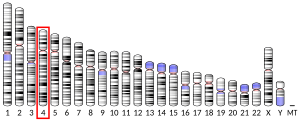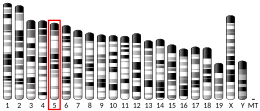CXCL10
CXCL10(C-X-C motif chemokine ligand 10)またはIP-10(interferon gamma-induced protein 10)は、ヒトではCXCL10遺伝子にコードされる約8.7 kDaのタンパク質である[5][6]。CXCL10はCXCケモカインファミリーに属するサイトカインである。
遺伝子
[編集]CXCL10遺伝子は4番染色体に位置し[7]、他のいくつかのCXCケモカイン遺伝子とクラスターを形成している[8]。
機能
[編集]CXCL10はIFN-γに応答して、単球、内皮細胞、線維芽細胞などいくつかの細胞種から分泌される[5]。CXCL10は、単球、マクロファージ、T細胞、NK細胞、樹状細胞に対する走化性因子、T細胞の内皮細胞への接着、抗腫瘍活性、骨髄系細胞の細胞のコロニー形成や血管新生の阻害など、いくつかの役割が知られている[9][10]。
このケモカインは、細胞表面のケモカイン受容体CXCR3に結合することで、その効果を発揮する[11]。
構造
[編集]CXCL10の結晶構造は3種類の異なる条件で決定されており、最大分解能は1.92 Åである[12]。
バイオマーカー
[編集]CXCL9、CXCL10、CXCL11は、心不全や左室機能障害の発症に関する有効なバイオマーカーとなることが示されており、これらのケモカインの濃度と有害な心臓リモデリングとの病態生理学的関連が示唆されている[13][14]。
臨床的意義
[編集]C型肝炎ウイルス(HCV)のジェノタイプ1型または4型の慢性感染において、抗ウイルス治療の完了後にウイルス学的著効(SVR)が達成されなかった患者では、治療前の基底レベルのCXCL10の血漿中濃度が上昇している[15][16]。血漿中のCXCL10濃度は肝臓内のCXCL10のmRNA量を反映しており、どちらも全てのHCVジェノタイプにおいてインターフェロン・ リバビリン併用療法時のHCV RNAの減少率の予測因子となる[17]。このことはHIVの共感染患者にも当てはまり、CXCL10濃度が150 pg/mL未満であることが良好な応答の予測因子となる。CXCL10濃度は、こうした治療困難な患者に対して治療の開始を促すために有用な指標となる可能性がある[18]。リーシュマニア症の原因となる病原体Leishmania majorは、GP63と呼ばれるプロテアーゼを用いてCXCL10を切断する。このことは、CXCL10がリーシュマニアのような特定の細胞内病原体に対する宿主防護機構に関与していることを示唆している[19]。
出典
[編集]- ^ a b c GRCh38: Ensembl release 89: ENSG00000169245 - Ensembl, May 2017
- ^ a b c GRCm38: Ensembl release 89: ENSMUSG00000034855 - Ensembl, May 2017
- ^ Human PubMed Reference:
- ^ Mouse PubMed Reference:
- ^ a b “Gamma-interferon transcriptionally regulates an early-response gene containing homology to platelet proteins”. Nature 315 (6021): 672–6. (1985). Bibcode: 1985Natur.315..672L. doi:10.1038/315672a0. PMID 3925348.
- ^ “Interferon-inducible gene maps to a chromosomal band associated with a (4;11) translocation in acute leukemia cells”. Proceedings of the National Academy of Sciences of the United States of America 84 (9): 2868–71. (May 1987). Bibcode: 1987PNAS...84.2868L. doi:10.1073/pnas.84.9.2868. PMC 304761. PMID 2437586.
- ^ “CXCL10 C-X-C motif chemokine ligand 10 [Homo sapiens (Human)] - Gene - NCBI”. 2024年5月10日閲覧。
- ^ “Physical mapping of the CXC chemokine locus on human chromosome 4”. Cytogenetics and Cell Genetics 84 (1–2): 39–42. (1999). doi:10.1159/000015209. PMID 10343098.
- ^ “IFN-gamma-inducible protein 10 (IP-10; CXCL10)-deficient mice reveal a role for IP-10 in effector T cell generation and trafficking”. Journal of Immunology 168 (7): 3195–204. (April 2002). doi:10.4049/jimmunol.168.7.3195. PMID 11907072.
- ^ “Human interferon-inducible protein 10 is a potent inhibitor of angiogenesis in vivo”. The Journal of Experimental Medicine 182 (1): 155–62. (July 1995). doi:10.1084/jem.182.1.155. PMC 2192108. PMID 7540647.
- ^ “The CXCR3 binding chemokine IP-10/CXCL10: structure and receptor interactions”. Biochemistry 41 (33): 10418–25. (August 2002). doi:10.1021/bi026020q. PMID 12173928.
- ^ “Crystal structures of oligomeric forms of the IP-10/CXCL10 chemokine”. Structure 11 (5): 521–32. (May 2003). doi:10.1016/S0969-2126(03)00070-4. PMID 12737818.
- ^ “Left Ventricular Dysfunction and CXCR3 Ligands in Hypertension: From Animal Experiments to a Population-Based Pilot Study”. PLOS ONE 10 (10): e0141394. (2015). Bibcode: 2015PLoSO..1041394A. doi:10.1371/journal.pone.0141394. PMC 4624781. PMID 26506526.
- ^ “CXCL10 Is a Circulating Inflammatory Marker in Patients with Advanced Heart Failure: a Pilot Study”. Journal of Cardiovascular Translational Research 9 (4): 302–14. (August 2016). doi:10.1007/s12265-016-9703-3. PMID 27271043.
- ^ “Interferon (IFN)-gamma-inducible protein-10: association with histological results, viral kinetics, and outcome during treatment with pegylated IFN-alpha 2a and ribavirin for chronic hepatitis C virus infection”. The Journal of Infectious Diseases 194 (7): 895–903. (October 2006). doi:10.1086/507307. PMID 16960776.
- ^ “IP-10 predicts viral response and therapeutic outcome in difficult-to-treat patients with HCV genotype 1 infection”. Hepatology 44 (6): 1617–25. (December 2006). doi:10.1002/hep.21407. PMID 17133471.
- ^ “Systemic and intrahepatic interferon-gamma-inducible protein 10 kDa predicts the first-phase decline in hepatitis C virus RNA and overall viral response to therapy in chronic hepatitis C”. Hepatology 51 (5): 1523–30. (May 2010). doi:10.1002/hep.23509. PMID 20186843.
- ^ “IP-10 predicts the first phase decline of HCV RNA and overall viral response to therapy in patients co-infected with chronic hepatitis C virus infection and HIV”. Scandinavian Journal of Infectious Diseases 42 (11–12): 896–901. (December 2010). doi:10.3109/00365548.2010.498019. PMID 20608766.
- ^ “Pathogen Evasion of Chemokine Response Through Suppression of CXCL10”. Frontiers in Cellular and Infection Microbiology 9: 280. (2019). doi:10.3389/fcimb.2019.00280. PMC 6693555. PMID 31440475.
関連文献
[編集]- “Mig and IP-10: CXC chemokines that target lymphocytes”. Journal of Leukocyte Biology 61 (3): 246–57. (March 1997). doi:10.1002/jlb.61.3.246. PMID 9060447.
- “The immunobiology of interferon-gamma inducible protein 10 kD (IP-10): a novel, pleiotropic member of the C-X-C chemokine superfamily”. Cytokine & Growth Factor Reviews 8 (3): 207–19. (September 1997). doi:10.1016/S1359-6101(97)00015-4. PMID 9462486.





